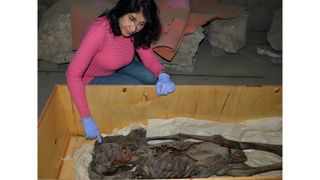From - Live Science
By- Kristel Tjandra
Edited by - Amal Udawatta

An ancient Egyptian woman died in so much pain, her muscles instantaneously locked up — freezing her final scream in place for 3,500 years, an analysis of the mummy, dubbed the "Screaming Woman," reveals.
The researchers also found that the woman had been embalmed in expensive imported substances and had all of her organs inside her body, suggesting a unique way of preservation.
The researchers revealed their findings in a new study published Friday (Aug. 2) in the journal Frontiers in Medicine.
"Mummification in ancient Egypt is still full of secrets," study co-author Sahar Saleem, a mummy radiologist at Kasr Al Ainy Hospital of Cairo University, told Live Science in an email. Intact organs are usually a sign of poor or neglected mummification, but the Screaming Woman was remarkably well preserved
"This was a surprise to me, as the classic method of mummification in the New Kingdom [circa 1550 to 1070 B.C.] included the removal of all organs except the heart," Saleem said.
Related: 7 famous mummies and secrets they've revealed about the ancient world
Archaeologists unearthed the "Screaming Woman" mummy, named after her gaping mouth, in Deir el-Bahari, near Luxor, Egypt, in 1935 while excavating the tomb of Senenmut, a prominent architect and government official who was rumored to be the secret lover of Queen Hatshepsut. The Screaming Woman was interred in a nearby burial chamber and
is likely a close family member of Senenmut, Saleem noted.
The mummy was adorned with a black wig and two scarab rings. Her natural hair had been dyed with henna and juniper. Electron microscopy revealed that the wig was made from date palm; an X-ray diffraction test showed it contained a mix of quartz, magnetite and albite crystals, likely to stiffen the locks and give her hair a black color, Saleem said. Wigs were commonly used for funerary purposes and in day-to-day life.

The secret to her preservation likely lies in her lavish embalming, Saleem and study co-author Samia El-Merghani, of the Egyptian Ministry of Tourism and Antiquities, found. Using infrared spectroscopy, they discovered traces of juniper resin and frankincense, which are luxurious products likely imported into Egypt from the Eastern Mediterranean and East Africa or Southern Arabia. The resin and frankincense prevented the body from decay caused by bacteria and insects.
This is not the only mummy discovered with a screaming expression — Prince Pentawere (1173 to 1155 B.C.) and Princess Meritamun (1525 to 1504 B.C.) were also unearthed with open mouths, Saleem noted.
"Opening of the mouth occurs when these muscles relax during sleeping or when they decompose after death," Saleem said. "In order to keep the deceased's mouth closed, embalmers frequently wrapped the mandible around the skull."
But this case was different: The gaping mouth was due to a painful death. "The mummy's screaming facial expression in this study could be read as a cadaveric spasm, implying that the woman died screaming from agony," Saleem said. Cadaveric spasm occurs when the muscles are contracted just moments before death, causing them to stiffen. This condition can occur in instances such as deaths by assault, suicide or drowning.

Comments
Post a Comment